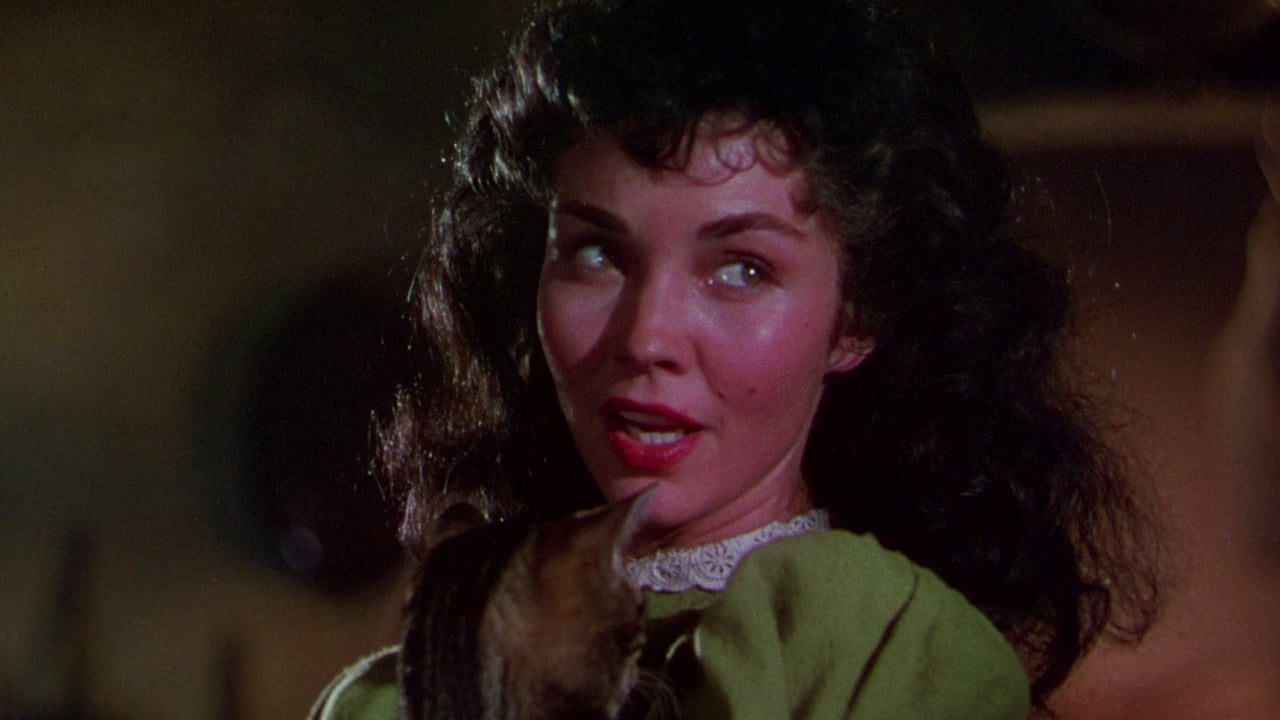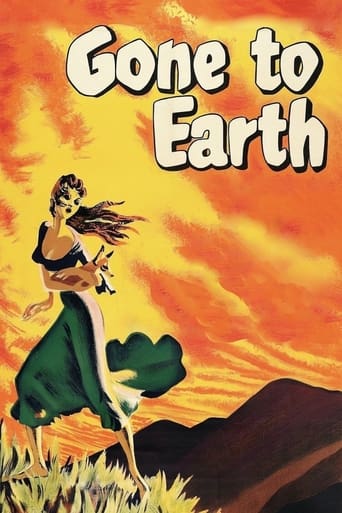

Sorry, this movie sucks
... View MoreFantastic!
... View MoreThe performances transcend the film's tropes, grounding it in characters that feel more complete than this subgenre often produces.
... View MoreGreat movie! If you want to be entertained and have a few good laughs, see this movie. The music is also very good,
... View MoreJennifer Jones is great as a carefree mountain Gypsy girl, ripe for matrimony with any man who can tear her away from her love of wild animals, and especially, her 'Foxy'. In its most basic form, this film much reminds us of the prior"Duel in the Sun", in which Jennifer plays a half breed. In both cases, she is a marginal member of conventional European society. Also, in both films, she has a choice between a conventional gentlemanly suitor, and an impatient bully, who nonetheless turns her on physically, and pursues her relentlessly. In the present film, the gentlemanly suitor is Pastor Edward Marston(Cyril Cusack), and the bully is squire Jack Riddin(David Farrer). She is not overly enthusiastic about marrying either, as her mother warned that, for the woman, marriage promises endless toll and suffering. Actually, Jack should have been favored as her husband by the promise to her father that she would marry the first man to pass by their cottage. This was, in fact, Jack, who came looking for her, but didn't know exactly where she lived. She hid when he knocked on the door, so he passed on. Later, the pastor, also smitten by her beauty and personality he experienced at a church social, comes calling, and after they get to know each other a bit, proposes marriage, he being judged the first to stop by their cottage, even though Jack actually was first. But she had had some unpleasant experiences with Jack, hence he was discounted. Soon, she would come to regret this decision, as Jack refused to give up the chase even after she was married. She came to seek his unrelenting passion over the unexciting Pastor Marston, and stayed a while in Jack's mansion. The parson showed up at Jack's mansion and quarreled with the two. It was decided that she would go home with Marston. But, now, Marston's mother who had lived with him for many years, voiced her determination to leave his house, if Hazel were to stay. Also, some churchmen came calling to advise Marston that he should give up Hazel, as her affair with Jack was now commonly known. Marston replied that he was giving up the clergy. Jack would express his frustration in being rejected by organizing a fox and hound event, in which he hoped that Hazel's Foxy would be caught. But, Hazel ran out of the house looking for Foxy, whom she found, and carried toward safety. But, she didn't quite make it. In her haste, falling down a deep well or mine shift that should have been covered. Jack had unwittingly destroyed not only Hazel's Foxy, but she herself. Edmond Knight was memorable as Hazel's father, who made some money playing his harp and repairing such, as well as making coffins, and other wooden objects. Several times, Jennifer sang a mellow song, with or without his accompaniment.....The meaning of the title is that the fox or whatever prey has gone into its burrow, where the hounds are too big to get in. It could also be applied to Hazel's unfortunate demise. We could, perhaps, project the theme to encompass all of the natural world as the victim of human overpopulation, overexploitation of natural resources, and moving into cities, away from their traditional ties with the natural world, which marginal peoples such as Gypsies still sometimes cared for.See it at YouTube
... View MoreOver the last ten years or so,I have been hearing a lot of people,from directors in great documentary's to people in the local DVD shop having conversations,and giving endless praise to what seems to be one of the now-most loved film making duo of the last sixty years:Emeric Pressburger and Michael Powell.And whilst I have seen some clips of A Matter of Life and Death and Peeping Tom,they have always been near the top of my list,of film makers whose work I should search out for.Sadly over the years I have kept them stuck on my list as peoples whose films I would pick up "next time",which has meant that I have always put them at the back of the queue. Recently,I was very surprised when my dad came back home one day,and he showed me that he had picked up a very rare restored Powell and Pressburger film,And from the moment that my eyes became transfixed on the great opening to this film,I realised that I had to make this my first Powell & Pressburger film right away..The plot:Whilst living with her cellist,coffin maker father,in a small house that is based in the rural town of Shropshire.Gypsy Hazel Woodus (who still reads her mothers old books of good spells and charms to help herself get through the day),one day finds a fox during her morning scroll.Feeling a special connection with the animal,Hazel decides to adopt the fox,and to give it a name (Foxy).Although her father's anger about her bringing the fox back with her,due to "Foxy" constantly trying to kill all of his chickens,Hazel remains extremely firm that show is not going to give Foxy away,and that he is going to remain her pet.On her walk back home,after having helped out some of the residents in the local area,Hazel is left startled when a horse and cart almost run her over!.With the man (John "Jack" Reddin) feeling very sorry about what had happened,John decides to give Hazel a ride to his place,so that she is able to relax and clean herself up a bit before he takes her home.As they arrive to his place Hazel is at a lost for words,when she realises that Reddin is a very wealthy man,who also has a stunning mansion.After having had a chance to relax Hazel seems to be developing some feelings for John.Stupidly,John loses patients and becomes a lot more aggressive in how he shows his feelings for her.Panicking Hazel (and Foxy) make a run for it to get back to their small village as fast as possible.Shortly after returning,Hazel impresses everyone by singing very beautifully at the local fair.Sadly,with the constant fear of Reddin returning to try and get together with her again,Hazel announces to her father that she will marry the first man that she sees.To everyones surprise,that man turns out to be the highly respected local vicar Edward Marston.Soon after Hazel and Edward have a very quick marriage and become man and wife.And although he is a very kind,sweet man,Marston becomes very uncomfortable when Hazel tries to show him any romantic gesture at all.Shortly after the marriage,Hazel is stunned when she finds out that John Reddin is going around her town,searching for her.And whilst she had first thought that John was not "her type" at all when they first met,she now feels a pretty strong attraction to Johns rugged looks,which leads to Hazel having to make the very tough decision if she should stay with her husband,or if she (and Foxy) should give Reddin a second chance..View on the film:With the screenplay of the film that Powell and Pressberger wrote,which is based on the book by Mary Webb.I feel that whilst it is not the most complex screenplay that has ever been written,it is still able to look at the issues that the film addresses in a very sophisticated manner.One of the main things that the film looks at is Hazel changing from being in an environment that is on the outskirts of town,where she and her father are able to live there lives the way their want,to her trying to fit into a much more wealthier environment,whilst trying to adopt her past learnings into an acceptable style.whilst most film makers would have turned this into a My Fair Lady-style film,with Hazel trying to become upper-class,Powell and Pressburger instead show,that the more Reddin tries to pull Hazel away from her life as a Gypsy,Hazel becomes more annoyed at how much Reddin is trying to get her to leave all her values on life behind,which she has used to follow her life by.Although all the cast give excellent performances,the shining star of the film is easily the gorgeous directing from Powell and Pressburger,and the cinematography by Christopher Challis.For the first half of the film the directors and Challis give the film the appearance of an enchanting Red Riding Hood/Brothers Grimm story,with the film being filled with Autumn colours that make all the excellent scenes of Hazel and her father living in the countryside almost looking like a living water colour painting!As Hazel starts distancing herself from her country life,the film makers take the look of the film into a brilliant,opposite direction.With the Reddins mansion,that due to being owned by a very rich person should be filled with light ,instead being filled with very dark,dimly lit shadows,the suggest that whilst the mansion may look as beautiful as the countryside on the outside,it is actually an almost nightmarish forest,that will try to keep you lost in the darkness of the building and the inhabitants in it,for a very long time..Final View on the film:One of the most beautiful looking film that I have ever seen.
... View MoreAmong the strangest, and loveliest, of the Archers films. As with so many of their films, its real subject is the profound, almost mystical, connection of people to their physical environment, most notably the British countryside. The much under-rated Jennifer Jones gives an utterly fearless performance, throwing herself into a role that sounds unplayable on paper. The Christopher Challis three-strip Technicolor photography is bold and gorgeous, underlining the central importance of the landscape. Strange in the best possible sense, in that it takes us somewhere we've never really been. Even the Bronte sisters couldn't capture rustic England as well. But they never had the benefit of Technicolor.
... View MoreA beautifully made and gently rolling film, almost surreal in content.Some moments almost seem off cue and through a breathtakingly simple narrative visual style, comes a story of innocence, passion and ultimate tragedy. The music is hypnotic and compliments the flow of the film.Superb performance by all - including 'Foxy'! If this film was made today it would be showered with Oscars.Finally, it is hard to see a comparable style in the British film industry prior to this and certainly nothing after it. It is this fact that I believe contributes to the films unique qualities.
... View More